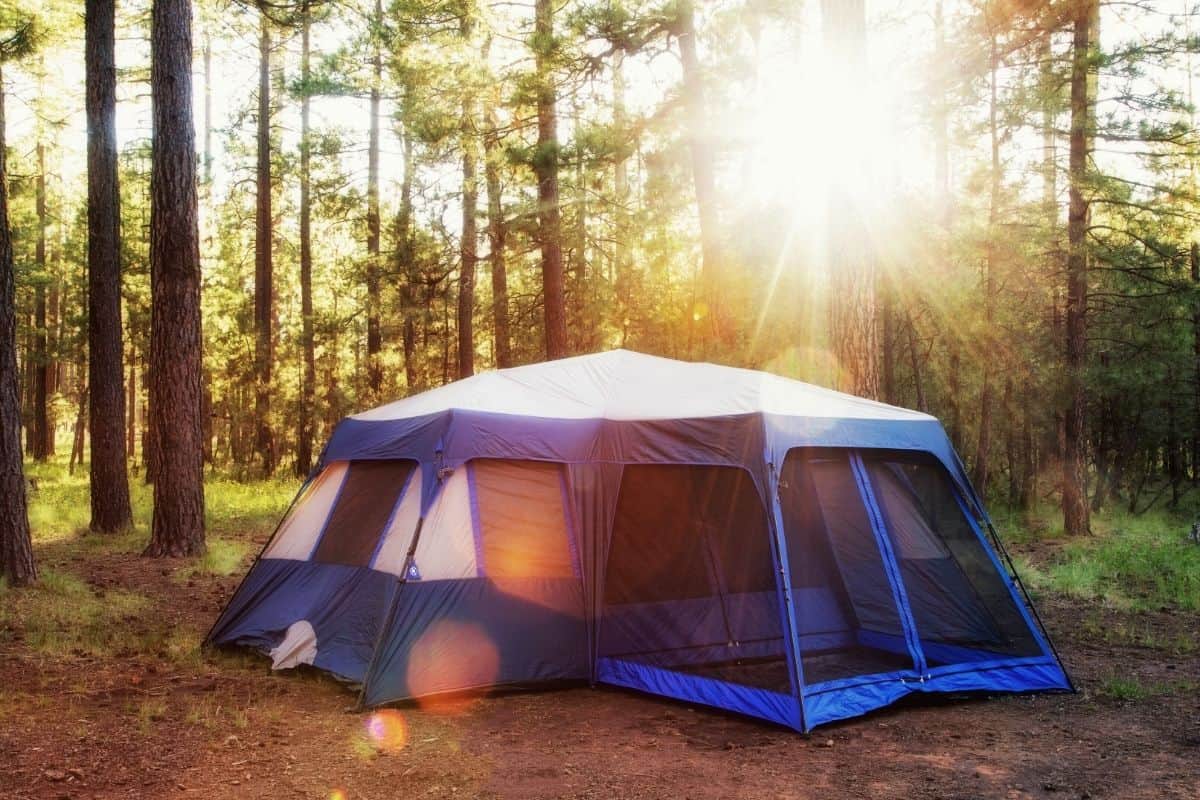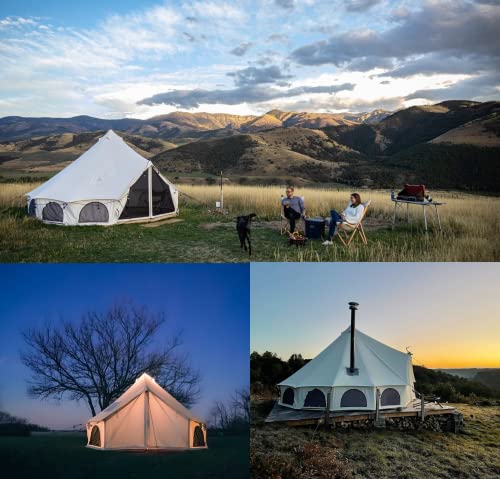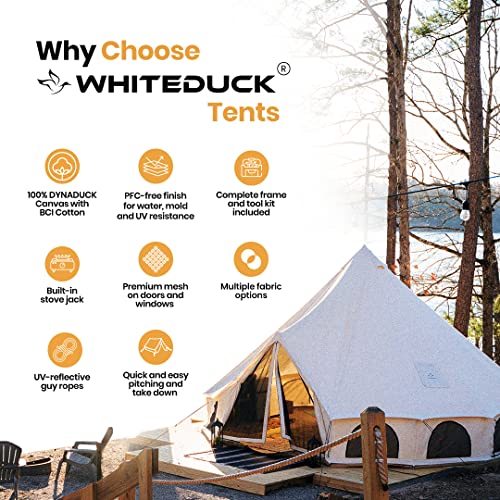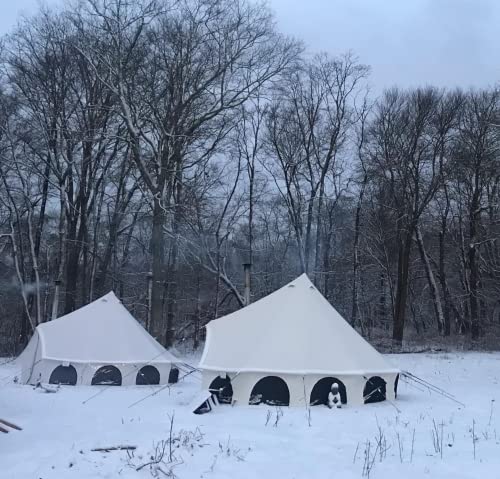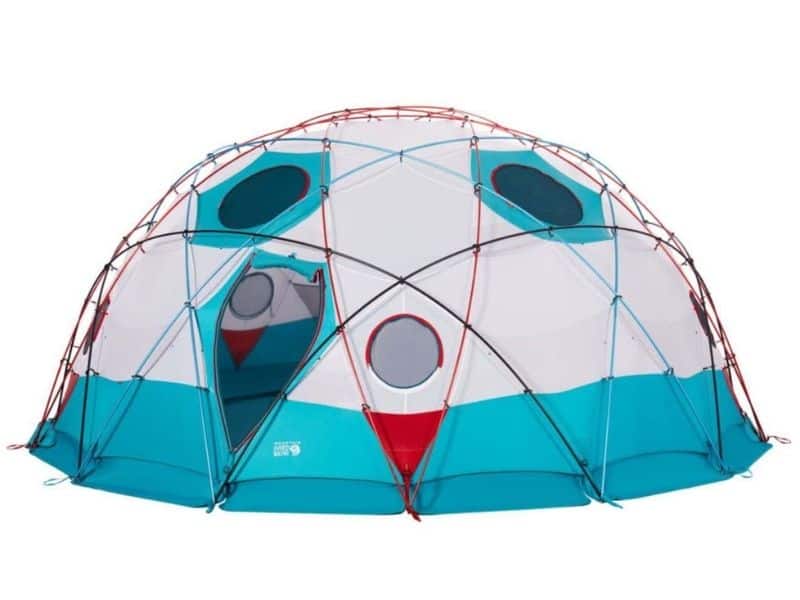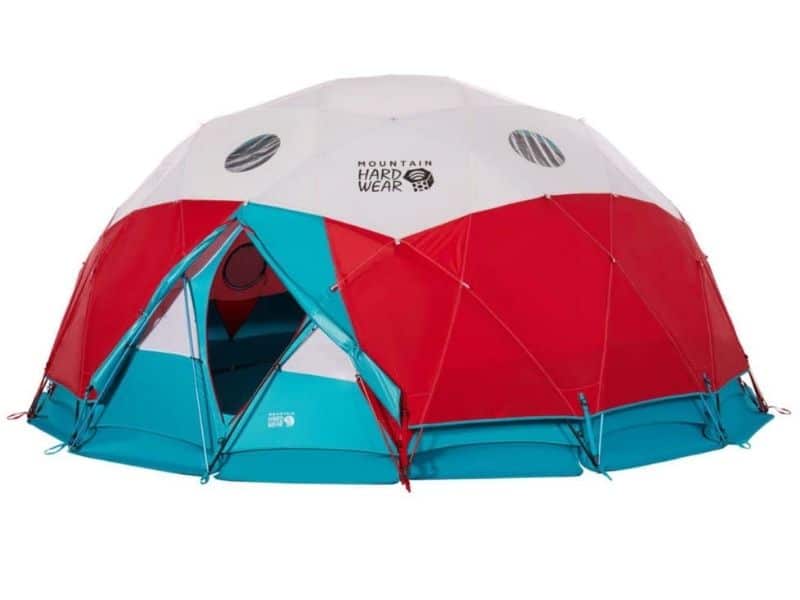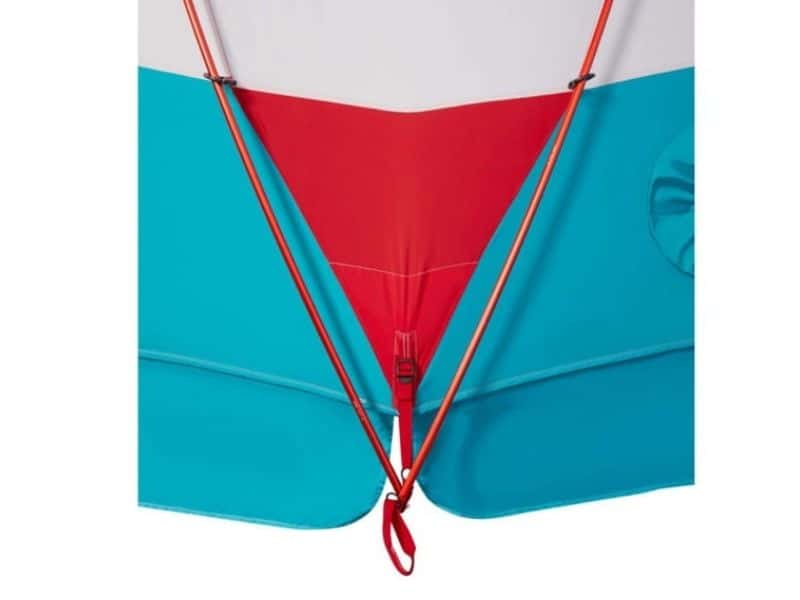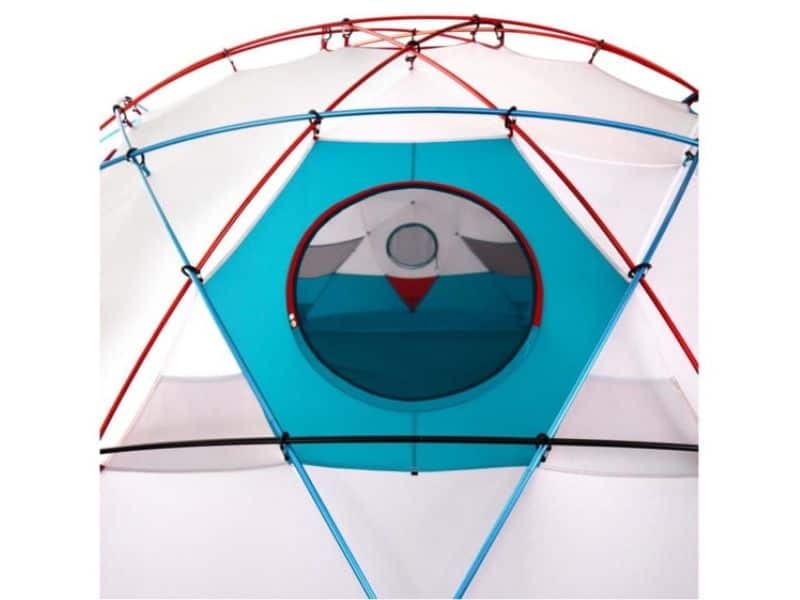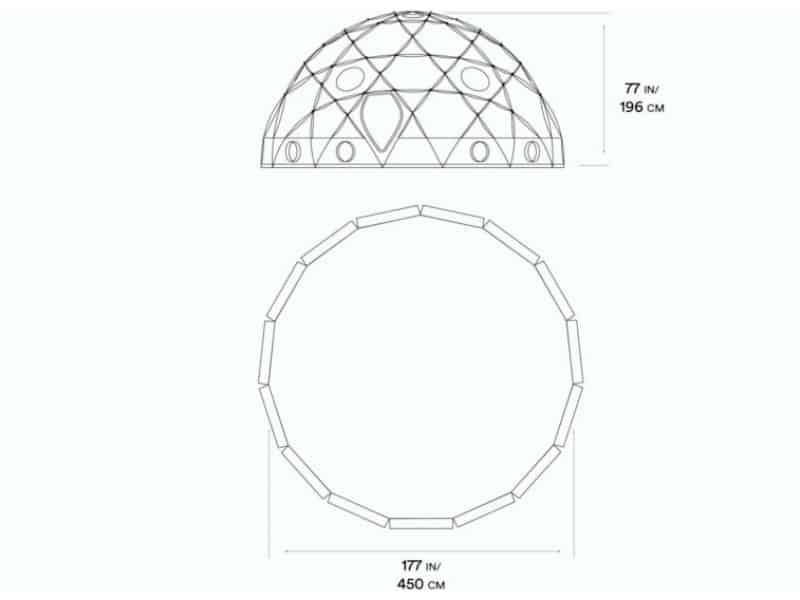Finding a tent for larger groups of friends and family can be challenging. You need one that is spacious yet affordable, with sufficient doors, pockets, and storage features for everyone’s gear, not to mention space for food, cooking equipment, and maybe even the dog. There’s a lot to consider!
In this guide, we’ll present 8 expertly selected camping tents for 10 people, highlighting their strengths, weaknesses, and the specific situations or campers they are most suited for. We’ll also explain our choice of the NTK Arizona GT as the overall top pick for a ten person tent.
Other notable models in this review are the CORE Family Cabin Tent with Screen Room, Ozark Trail Dark Rest 10-Person Instant Cabin Tent, Browning Camping Big Horn Tent, White Duck Avalon Bell Canvas Tent, Mountain Hardwear Stronghold Dome Tent, UNP Camping Tent 10-Person, and Coleman WeatherMaster 10-Person Tent.
Below our reviews, you’ll also find detailed buying advice to help you choose the ideal model for your trip type and budget. Key considerations include tent shape, livability based on style and floor space, ease of setup, weather protection (rainfly coverage and hydrostatic head), ventilation, weight & portability, as well as additional features.
Table of Contents
At a Glance: Quick Recommendations
-
Editor’s Choice:
NTK Arizona GT 10-Person Tent
“This feature-rich, waterproof, and spacious tent ticks every box for 2-, 3-, or even 4-season camping.” -
Best for Livability:
CORE Family Cabin Tent with Screen Room
“The biggest tent on our list, but also one of the easiest to pitch. Ideal if you need extra space.” -
Best Instant:
Ozark Trail Dark Rest 10-Person Instant Cabin Tent
“Not the best in wet weather, but ideal for campers who like to lie in bed late!” -
Best Value:
Browning Camping Big Horn Tent
“This cabin-style tent’s near-vertical walls mean it offers oodles of headroom from both end to end and side to side.” -
Best Canvas:
White Duck Avalon Bell Canvas Tent
“A burly, fully-waterproof tent that’s built to last a lifetime.” -
Best 4-Season:
Mountain Hardwear Stronghold Dome Tent
“Pricey, but ideal for winter camping or expeditions.” -
Best Budget:
UNP Camping Tent 10-Person
“Perfect for summer family camping adventures.” -
Honorable Mention:
Coleman WeatherMaster 10-Person Tent
“Offers a nice combo of decent waterproofing, a spacious interior, easy setup, and value-adding features.”
What model is the Best 10 Man Tent on the market?
We tested a number of products to find the best 10-person tent on the market, and shortlisted the following.
- NTK Arizona GT 10-Person Tent
- CORE Family Cabin Tent with Screen Room
- Ozark Trail Dark Rest 10-Person Instant Cabin Tent
- Browning Camping Big Horn Tent
- White Duck Avalon Bell Canvas Tent
- Mountain Hardwear Stronghold Dome Tent
- UNP Camping Tent 10-Person
- Coleman WeatherMaster 10-Person Tent
NTK Arizona GT 10-Person Tent
Editor’s ChoiceInterior Space: 140 sq. ft. ⸱ Peak Height: 6’ 2” ⸱ Weight: 26.5 lbs
While there have been many worthy contenders to its throne, the NKT Arizona GT has earned our best 10-person tent award for three years running. The reason? It ticks every box that needs ticking…and then some!
This 10-person extended dome tent offers 140 square feet of interior space. While this doesn’t make it the roomiest on our list, there’s more than enough space there for ten adults, never mind a mix of adults and kids. It also has a generous peak height of 6’ 2”, meaning only the very tallest of campers will be inconvenienced by having to stoop when standing.
While named after one of the US’s most notoriously sultry states, the NKT is fit for use in a variety of climates. Heading on a camping trip to rain-prone areas like the Pacific Northwest or Scotland? If so, the full-coverage, 2,500 mm rain fly has your back. Camping in hot weather? Simply shed the fly and the ample mesh ceiling will ensure you have plenty of airflow.
Features-wise, the NKT Arizona is up there with the best extended dome tents out there. In addition to its two large vestibules, it boasts an e-port for hook-up cables, multiple interior pockets, a gear loft, vents, and large D-shaped doors for easy entry and exit.
PROs
- Spacious (can fit three double air mattresses and two singles)
- Full-coverage rainfly
- Waterproof (2,500 mm HH)
- Room divider to create separate rooms
- Large vestibules, gear loft, and utility pockets
CONs
- Quite pricey
- Fiberglass poles
Bottom-Line: Roomy, feature-rich, and ideal for both cold-weather and summer camping.
CORE Family Cabin Tent with Screen Room
Best for LivabilityInterior Space: 204 sq. ft. ⸱ Peak Height: 86” ⸱ Weight: 36.24 lbs.
The CORE Family Cabin Tent with Screen Room stands out as the most habitable 10-person tent on our list, taking convenience and livability to the next level.
It uses poles that are pre-attached to the tent body to allow for easy-breezy, instant pitching, and boasts a huge screen room that’s ideal for rainy-day lounging, bug-free nighttime card games, or squeezing in additional sleepers
This instant setup tent has a whopping 204 square feet of interior space. In the main sleeping area, there’s enough room for three queen air mattresses and a single, while the large screen room can accommodate a further three or four sleepers comfortably.
Although this is the largest tent on our list, it has a lot more going for it than size alone.
For starters, there are plenty of storage pockets in the walls and a large gear loft, which means that all of the Core’s 204 square feet of interior space is usable. There are also huge mesh doors and windows, and adjustable ground vents that draw in cool air from the ground while allowing hot air to escape. This makes it an excellent performer in warm weather.
Like most instant cabin tents, the Core Cabin uses a partial-coverage rain fly. This, coupled with the fly’s low waterproof rating, means it’s not a good bet for camping in wet weather. For that, we recommend the NKT Arizona or Coleman WeatherMaster.
PROs
- Enormous!
- Multiple storage pockets
- Takes two minutes to set up
- Electrical cord access port
- Screen room provides extra sleeping or storage space
- Two rooms and two doors
CONs
- Lacks weather resistance
Bottom-Line: One of the best tents out there for buyers keen to enjoy some hassle-free camping.
Ozark Trail Dark Rest 10-Person Instant Cabin Tent
Best InstantInterior Space: 140 sq. ft. ⸱ Peak Height: 78” ⸱ Weight: 20 lbs.
If a quick and easy setup is your priority, then the Ozark Trail Dark Rest is our top choice for the best ‘instant’ 10-person tent. Thanks to the use of pre-attached poles and a central pole hub that opens like an umbrella, it can be pitched in roughly 2 minutes!
Instant pitching aside the Trail Dark Rest has many admirable features, but none more so than its “dark room” technology, which effectively blocks out 90% of sunlight to keep the tent cool inside on hot days and let you carry on getting your beauty sleep long after the sun rises.
But the Dark Rest has more going for it than fancy technologies alone.
Inside, you have 140 square feet of sleeping space. Although there are no vestibules, there are plenty of wall pockets for gear storage. Other nice features include an e-port, lantern hook, double doors, and huge mesh windows for ventilation.
The Dark Rest’s only major downside is its lack of weather resistance. While the flooring is fully waterproof, its partial-coverage rain fly will only keep you dry in very light showers, not in heavy rain.
PROs
- Blocks out sunlight
- 2 ground vents
- 2 large doors
- Roomy
- Room divider
- Affordable
CONs
- Not suitable for cold and rainy weather
- No vestibules
Bottom-Line: Easy to pitch, roomy, well-ventilated, and perfect if you like to continue getting some shut-eye after the sun rises.
Browning Camping Big Horn Tent
Best ValueInterior Space: 150 sq. ⸱ Peak Height: 87” ⸱ Weight: 34 lbs. 11 oz.
If you’re seeking a robust family cabin tent that doesn’t break the bank, the Browning Camping Big Horn is worth considering for its great value.
The Big Horn is the second cheapest tent on our list, after the UNP 10-Person, but outperforms many pricier tents in several important metrics. It’s roomy, feature-rich for its price, durable, and an absolute breeze to pitch.
The Big Horn gives you a generous 150 square feet of interior space and has a peak height of 87 inches, making it one of the more spacious tents on our list. The straight walls also help to maximize headroom from end to end. While there are no vestibules or gear lofts, it has plenty of mesh pockets for gear storage.
The Big Horn Series uses a combination of fiberglass tent poles and steel uprights for added stability in strong winds. It also comes with a groundsheet, a partial-coverage polyester fly that can fend off light rain, guy ropes, and steel stakes.
In terms of features, the Big Horn isn’t a standout. It does however have six large windows and double doors for ventilation and a room divider for privacy.
PROs
- Spacious
- Great peak height
- Easy to set up
- Plenty of pockets
- Good ventilation
CONs
- No vestibules
- Partial-coverage rainfly
Bottom-Line: An affordable, well-made, and durable tent that scores highly in the livability metric.
White Duck Avalon Bell Canvas Tent
Best CanvasInterior Space: ~150 sq. ft. ⸱ Peak Height: 11’ 2” ⸱ Weight: 95 lbs.
If you want to step-up your family camping trips to be a more luxurious affair then the White Duck Avalon Bell is our choice for best canvas model.
This home away from home is made with extra-burly, waterproof, 10.10 oz. army duck cotton canvas. It also has double-stitched seams with reinforced corners for added durability and uses galvanized steel poles in combination with a proprietary shock-absorbing grounding system which makes it a standout performer in bad weather.
The Avalon Bell is the only tent on our list, excluding the NTK Arizona, that is suitable for year-round use. In summer, the breathable cotton canvas and built-in roof vents help prevent overheating. In winter, the pre-installed, heat-resistant, silicone-coated stove jack can be used to keep everyone inside extra-cozy, no matter how low the temperature gets.
The only downsides to the Avalon Bell are its weight (which makes setup quite labor-intensive!) and price.
PROs
- Waterproof
- Incredibly spacious
- Robust
- As durable as they come
CONs
- Pricey
- Heavy
Bottom-Line: A luxury glamping, high-quality tent that takes comfort and durability to a whole new level.
Mountain Hardwear Stronghold Dome Tent
Best 4-SeasonInterior Space: 171 sq. ft. ⸱ Peak Height: 77” ⸱ Weight: 48 lbs. 12 oz.
If winter camping or alpine expeditions are in your plans, the Mountain Hardwear Stronghold is our recommendation for the best 4-season tent.
This beast of a tent is of the “bombproof” variety, i.e. those that can withstand pretty much anything the weather can throw at them. Sure, the Stronghold costs about the same price as a decent second-hand car, but in return for your outlay, you’ll be getting something truly exceptional.
The Stronghold provides 171 square feet of living space and has a peak height of 77 inches. While its dome-style design means headroom decreases away from the center, it’s plenty roomy for 10-12 sleepers.
This tent is designed for the world’s harshest environments, using a geodesic design that makes it pretty much impervious to all but hurricane-force winds. Even better, its floor has a 10,000mm hydrostatic head, and fly 1,500mm, meaning you should stay dry even in a deluge!
While overkill for 2- or 3-season camping, the Stronghold has plenty of vents and mesh panels as well as boasting 2 doors to boost airflow, so even if you do decide to camp in warmer winter conditions you won’t be overheating.
PROs
- Waterproof
- As sturdy as they come
- Durable
- Roomy
CONs
- (Very) expensive!
- No vestibules
- Overkill for most campers
Bottom-Line: A serious tent for adventures in serious conditions.
UNP Camping Tent 10-Person
Best BudgetInterior Space: 162 sq. ft. ⸱ Peak Height: 78” ⸱ Weight: 23.1 lbs
Our top budget pick, the UNP 10-Person Tent, provides ample space at a wallet-friendly price, making it perfect for family camping trips with plenty of room for both sleeping and storing your camping gear.
Measuring 18ft x 9ft x 78in, the UNP would be better termed a 10-12 person tent. It can easily fit in 10 sleeping bags or 3 queen-size airbeds and yet is light enough for easy setup.
Made with high-quality Polyester 185T PU1000mm fabric it’s sufficiently waterproof to deal with light rain showers, something that can’t be said of all tents in its price range. The UNP also features double doors and large mesh windows for optimal access and ventilation.
This tent also comes with a room divider for increased privacy, lightweight fiberglass poles, and is extremely easy to set up, going from packed to pitched in under 10 minutes with two people lending a hand.
PROs
- Huge!
- Cheap!
- Good peak height
- Lightweight
- Waterproof
CONs
- No vestibules
Bottom-Line: A lightweight, spacious, well-designed, and relatively cheap 10-person tent that can hold its own in inclement weather.
Coleman WeatherMaster 10-Person Tent
Honorable MentionInterior Space: 153 sq. ft. ⸱ Peak Height: 6’ 8” ⸱ Weight: 31 lbs.
Worth a mention on our list is the Coleman WeatherMaster, a remarkably spacious and water-resistant ten-man tent that’s the ideal choice for groups that prioritize personal space.
This tent gives a truly home-like feel with its 17 x 19-foot floor area (enough room for 3 queen-sized mattresses) and 6′ 8″ peak height. It is also equipped with a hinged front door and a zippered back door for easy entry and uses Coleman’s WeatherTec system to help keep you and your camping companions dry in wet weather.
The included room dividers in this 10-person tent provide you with privacy, while the adjustable ventilation system allows you to more easily control the temperature inside the tent. Additionally, everything for the WeatherMaster 10-man tent is color-coded and therefore easy to set up. Partner up with someone to do the pitching and you’ll have it done in less than 20 minutes.
PROs
- Massive!
- Comes with room dividers
- Sets up in under 20 minutes
- 80-inch peak height
CONs
- Heavy
- No vestibules
Bottom-Line: A 10 people tent that can actually accommodate 10 adult sleepers! One of the best 10-person tents out there for groups who need an extra-large shelter without compromising on ease of setup and weatherproofing.
How to Choose a 10-person camping tent?
When it comes to choosing a family camping tent the following features are important to focus on.
- Tent Shape
- Livability
- Ease of Setup
- Weather Protection
- Ventilation
- Weight & Portability
- Extra Features
Tent Shape
The primary tent shapes to choose from are domes and cabins. Dome tents offer excellent weather resistance, while cabin tents prioritize enhanced livability.
Dome tents like the Mountain Hardwear Stronghold are the best performers in inclement weather.
First, the curvature of the roof and walls ensures that rainwater doesn’t pool in the rainfly and cause leaks.
Secondly, they mostly have a geodesic design that provides added structural stability in high winds.
Finally, their sloping, aerodynamic walls provide less resistance to crosswinds. In this case, less resistance is a good thing because it means the wind glides over the structure as opposed to buffeting it and potentially collapsing the walls.
On the downside, a dome-style tent is less livable than a cabin tent because there’s less headroom the further you move away from the center.
Cabin tents are, as the name suggests, cabin-shaped shelters made with polyester and/or canvas instead of wood. Their straight walls ensure that headroom remains nearly uniform from end to end and side to side, and most models have a center height of over 6 feet. This allows tall campers to move around inside without hunching – a considerable boon for livability.
On the downside, those straight walls do mean that a cabin-style tent isn’t the most stable in high winds.
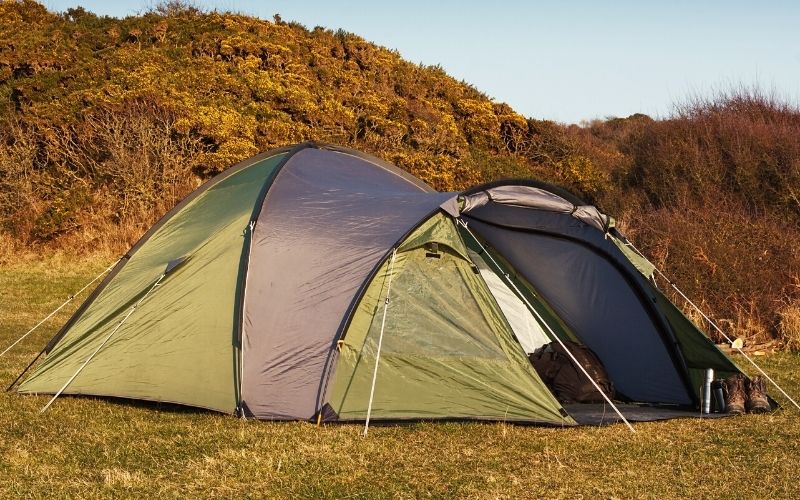
Livability
Tent livability hinges on key factors such as floor space, center height, vestibule space, and storage features.
Your tent should provide each adult sleeper with roughly 14 square feet of floor space, though 10-12 sq. ft. will be enough for kids. Peak height should ideally be high enough to allow everyone to move around inside the tent without hunching, though this is rarely the case with a dome-shaped tent.
The MH Stronghold has the lowest peak height on our list (77”), while the White Duck Avalon Bell (11’ 2”) has the highest.
Storage features also contribute to livability since storing your gear outside or above the sleeping area frees up floor space for humans. These features can include vestibules, screen rooms, gear lofts, and wall pockets.
While all of the tents on our list have wall pockets, the only two with a gear loft and external storage (a vestibule or screen room) are the NKT Arizona and CORE Family Cabin Tent.
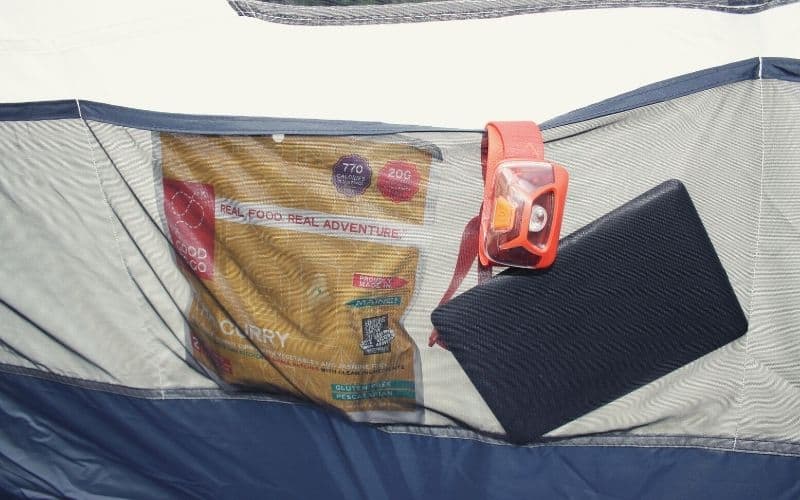
Ease Of Setup
The sheer size of ten-person tents makes them more challenging to pitch than their smaller counterparts, highlighting the importance of prioritizing ease of setup in your pre-purchase priorities.
First of all, look for a tent with a color-coded pole system. This helps you to make sure all the poles are in the right place and prevents a lot of time-consuming trial and error. If the poles are pre-attached, all the better!
Secondly, look for a freestanding design, i.e. one that stands without having to first support it with guy lines and tent stakes.
Thirdly, if one-piece pitching is an option, it’s well worth having. One-piece pitching means that the rainfly and the inner body can be pitched in unison, which saves the hassle of pitching both separately.
Finally, make sure the weight of your tent is low enough that you and your camping companions will be able to pitch it. Most ten-person tents are designed to be set up by 2-4 people, but if there are only 2 adults in the group capable of doing the pitching, it’s wise to choose a tent at the lower end of the scale weight-wise.
The easiest to pitch on our list is the Ozark Trail Dark Rest Instant Tent, which can be set up in 2-3 minutes thanks to its use of pre-attached poles and a central pole hub. The toughest to pitch is the White Duck Canvas Bell. This weighs a mighty 95 lbs. And, like most canvas tents, will need 2 or 3 extra pairs of hands to set up.
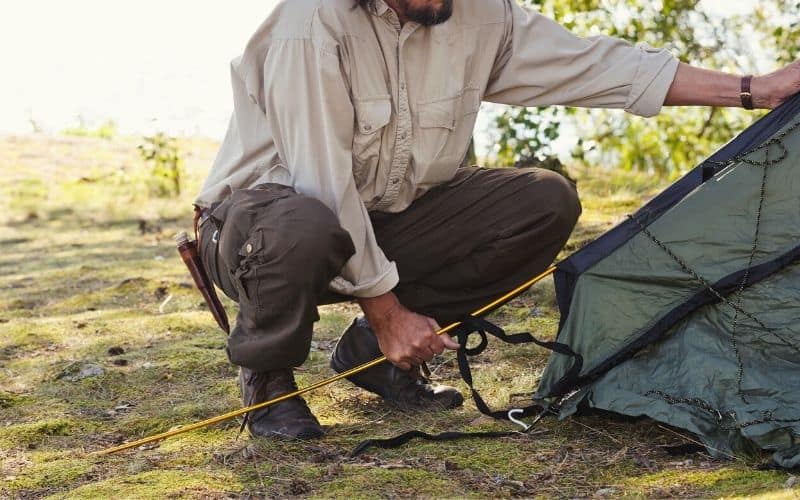
Weather Protection
A tent’s weather protection primarily depends on two factors: the coverage offered by the rainfly and the hydrostatic head of its fabric.
Rainfly Coverage
Choose tents with a full-coverage rainfly for camping in challenging weather conditions. As the name suggests it offers comprehensive protection by shielding the entire tent from the elements.
A partial-coverage rainfly, on the other hand, will leave part of the inner tent exposed to the elements. While this improves ventilation, it also means it is unlikely to withstand heavy rainfall.
In our review, only the Mountain Hardware Stronghold has a full-coverage rainfly, though the Whiteduck Avalon Bell is made with waterproof fabric. As such, these are the only fully waterproof tents on our list.
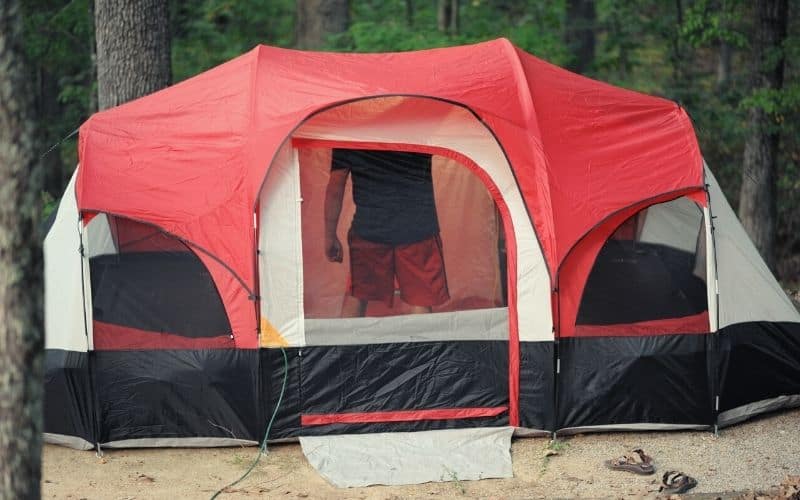
Hydrostatic Head
Hydrostatic head (HH) is the rating system used to measure the degree of water resistance in a fabric. Measured in millimeters, it normally appears in product specs as a number followed by ‘mm’ – for example, 2,000 mm, 1,200 mm. A higher hydrostatic head (HH) rating indicates a more waterproof fabric.
For example, a rain fly with a HH rating of 2,500 mm, like the NKT Arizona, will offer superior protection than one with a HH of 1,000 mm, such as the UNP 10-Person.
Ventilation
Tents may incorporate various ventilation features, such as side or floor vents, roof vents, mesh windows, a mesh ceiling, and/or double doors.
Your shelter’s ventilation features are the main foil for stuffiness, overheating, and condensation. While stuffiness and overheating are uncomfortable, condensation can become a serious scourge by soaking you, your sleeping bag, and other gear.
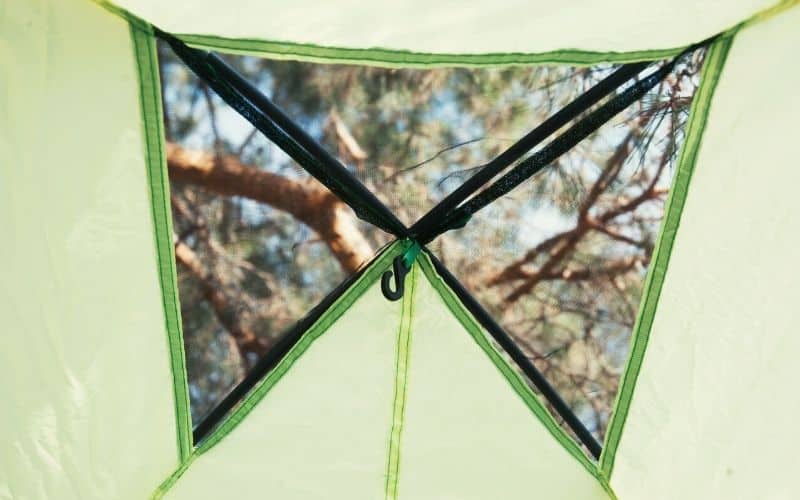
Weight & Portability
The tents on our list are designed for car camping and may be too heavy and bulky to carry over long distances. However, you still need to transport your tent from your vehicle to your campsite, which can be challenging if you bench or deadlift less than 400 lbs! Relatively lighter tents are also generally easier to pitch.
The heaviest tent on our list is the White Duck Avalon Bell, which weighs 95 lbs. While it comes with a functional carry bag, you’ll need 2 or 3 strong friends at a minimum to pitch this one. The lightest model on our list is the Ozark Trail Dark Rest, which tips the scales at a far more manageable 20 lbs.
Features
Features are non-universal extras that significantly enhance a tent’s convenience, livability, and practicality. Key additions include double doors, vestibules for gear storage, and room dividers for increased privacy. Smaller extras like awnings, electric access ports, gear lofts, and wall pockets also contribute to the tent’s overall functionality.
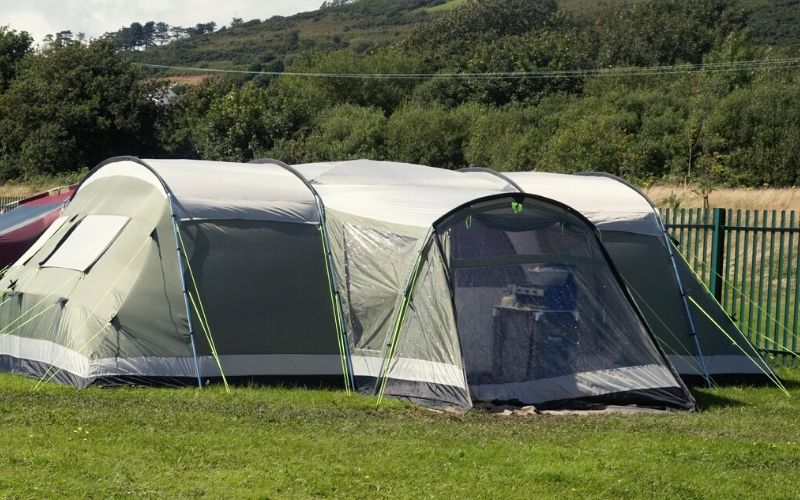
Best 10-Person Tent: The Verdict
Our favorite 10 person family tent is the NKT Arizona, ticking all our boxes. It’s waterproof, roomy, easy to pitch, and loaded with features to enhance convenience and comfort.
If the price tag of the NKT is a little too high for your budget, then there are other tents we would recommend such as the UNP 10-Person or Browning Big Horn, both of which offer great bang for your buck and are ideal for summer camping.
If you’re looking for a luxury “home away from home”, the White Duck Canvas Bell is a perfect choice. This glamping tent is more of a palace than a bolthole, and it oozes quality from every stitch and seam.
Finally, if winter camping or long-term expeditions are in your future plans, be sure to check out the Mountain Hardwear Stronghold. If Chuck Norris was a tent…!
We hope you enjoyed this article on the top-rated 10 person tents available. If you have any questions, drop us a line in the comments box below. And feel free to share it with your friends!
